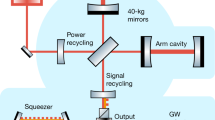Abstract
THE cosmic radiation is defined as that small Jportion of the ‘penetrating radiation’ which is of cosmic origin. The main purpose of this paper is to present a preliminary report upon some very Tecent work which throws new light upon the properties of these extraordinary rays, and shows that still harder ones exist than had heretofore been found, rays capable of penetrating 190 feet of water, or about 16-7 feet (5 metres) of lead, before being completely absorbed.
This is a preview of subscription content, access via your institution
Access options
Subscribe to this journal
Receive 51 print issues and online access
$199.00 per year
only $3.90 per issue
Buy this article
- Purchase on Springer Link
- Instant access to full article PDF
Prices may be subject to local taxes which are calculated during checkout
Similar content being viewed by others
References
Substance of an evening discourse, with additions, delivered by Prof. Millikan at Leeds, on Sept. 2, during the meeting of the British Association.
Swann, Phys. Rev. (29, 372; 1927), finds the ionisation due to such rays on the summit of Pike's Peak to be 0.75 per c.c. per sec. per atmosphere, while we found them in the same place to be close to 5 ions.
Hoffmann, Ann. der Physik (82, 413; 1927), finds the ionisation at sea-level 0.29 per c.c. per sec. on the assumption, taken from Kolhrster's 1926 findings (Zeit. f. Physik, 36, 147; 1926), that the absorption coefficient is invariant and of value H2O = 22 - 103 cm.1. We, on the other hand (Phys. Rev., 28, 851; 1926), found the absorption coefficient definitely variable (the rays therefore inhomogeneous), and the ionisation at sea-level 1.4 ions.
McLennan and Burton, Phys. Rev., 16, 184; 1903.
Rutherford and Cooke, Phys. Rev., 16, 183; 1903.
Gockel, Phys. Zeit., 11, 280; 1910.
Richardson, NATURE, 73, 607, 1906; 74, 55; 1906.
Hess, Phys. Zeit., 12, 998; 1911; and 13, 1084; 1912.
Kolhrster, Phys. Zeit., 14,1153; 1913; and Verh. d. Deut. Phys. Ges., July 30, 1914.
Millikan and Bowen, Phys. Rev., 22, 198; 1923; and 27, 353; 1926.
Kolhrster, Sitz. Ber. d. Preuss. Akad., 34, 366, Dec. 20, 1923.
Phys. Rev., 23, 778; April 1924. Also 28, 851; 1926.
Radioactivity, Bull. Nat. Res. Council, Kovarik and McKeehan, p. 114, 1925.
œNeuerdings neigt man immer mehr der Ansicht zu, die Hhenstrahlung als eine Erscheinung aufzufassen, deren Ursprung im Kosmos zu suchen ist. Again: œDa för die erstere Auffassung der Hhenstrahlung als einer aus den hheren Atmosphrenschichten stammenden bisher keinerlei direkte Andeutung gefunden wurde, so sprechen die augenblicklichen Verhltnisse mehr zugunsten einer kosmischen Erklrung.
Hoffmann, Phys. Zeit., 26, 40, 669; 1925.
Downey, Phys. Rev., 20, 186; 1922. Fruth, Phys. Rev., 22, 109; 1923.
Steinke, Zeit. f. Phys., 42, 570; 1927.
Böttner,Zeit. f. Geophys., 2, 190; 1926.
Kolhrster, Naturwissenschaften, 14, 936; 1926.
Hoffmann Ann. der Phys., 82, 417; 1927.
Dirac, Proc. Roy. Soc., 109, 206; 1925.
Eddington, œStars and Atoms, p. 69 (Oxford Press, 1927).
Rights and permissions
About this article
Cite this article
MILLIKAN, R., CAMERON, G. New Results on Cosmic Rays. Nature 121, 19–26 (1928). https://doi.org/10.1038/121019a0
Issue Date:
DOI: https://doi.org/10.1038/121019a0
This article is cited by
-
History of Research in Cosmic Rays*
Nature (1930)
Comments
By submitting a comment you agree to abide by our Terms and Community Guidelines. If you find something abusive or that does not comply with our terms or guidelines please flag it as inappropriate.



